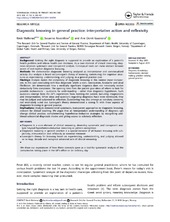| dc.contributor.author | Malterud, Kirsti | en_US |
| dc.contributor.author | Reventlow, Susanne | en_US |
| dc.contributor.author | Guassora, Ann Dorrit | en_US |
| dc.date.accessioned | 2020-08-04T08:13:33Z | |
| dc.date.available | 2020-08-04T08:13:33Z | |
| dc.date.issued | 2019 | |
| dc.Published | Malterud K, Reventlow S, Guassora AD. Diagnostic knowing in general practice: interpretative action and reflexivity. Scandinavian Journal of Primary Health Care. 2019;37(4):393-401 | eng |
| dc.identifier.issn | 1502-7724 | |
| dc.identifier.issn | 0281-3432 | |
| dc.identifier.uri | https://hdl.handle.net/1956/23388 | |
| dc.description.abstract | Background: Getting the right diagnosis is supposed to provide an explanation of a patient’s health problem and inform health care decisions. As a core element of clinical reasoning, diagnosis deserves systematic and transparent analysis. Conceptual tools can make doctors become aware of and explore diagnostic knowing. Methods: We demonstrate diagnostic knowing analysed as interpretative and contextualised activity. Our analysis is based on Lonergan’s theory of knowing, constituting the cognitive structures as experiencing, understanding, and judging, in a general practice case. Findings: Analysis makes the complexity of diagnostic knowing in this context more transparent, in this case concluding with four diagnostic labels: a corn, constipation, headache and atrial fibrillation. We demonstrate how a medically significant diagnosis does not necessarily evolve deductively from complaints. The opening lines from the patient give ideas of where to look for possible explanations – questions for understanding – rather than diagnostic hypotheses. Such questions emerge from the GP’s experiences from meeting the patient, including imaginations and interpretations. When ideas and questions regarding diagnoses have been developed, they may be judged and subjected to reflection. Questioning may also emerge as transitory concerns, not extensively ruled out. Lonergan’s theory demonstrated a strong fit with these aspects of diagnostic knowing in general practice. Implications: Analysis demonstrated systematic, transparent approaches to diagnostic knowing, relevant for clinical teaching. We argue that an interpretative understanding of diagnosis can change clinical practice, complementing hypothetico-deductive strategies by recognising additional substantial diagnostic modes and giving access to scholarly reflection. | en_US |
| dc.language.iso | eng | eng |
| dc.publisher | Taylor & Francis | eng |
| dc.rights | Attribution CC BY | eng |
| dc.rights.uri | http://creativecommons.org/licenses/by/4.0/ | eng |
| dc.title | Diagnostic knowing in general practice: interpretative action and reflexivity | en_US |
| dc.type | Peer reviewed | |
| dc.type | Journal article | |
| dc.date.updated | 2020-01-11T20:45:51Z | |
| dc.description.version | publishedVersion | en_US |
| dc.rights.holder | Copyright 2019 The Authors | |
| dc.identifier.doi | https://doi.org/10.1080/02813432.2019.1663592 | |
| dc.identifier.cristin | 1750519 | |
| dc.source.journal | Scandinavian Journal of Primary Health Care | |

